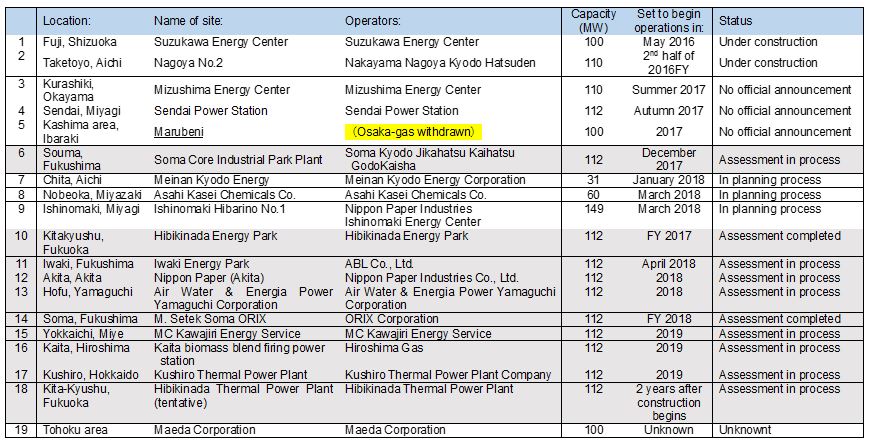[:ja]環境省は2015年末、「今後の小規模火力発電等の環境保全について(課題・論点のとりまとめ)」を公表しました。小規模火力発電をめぐる問題とは、東日本大震災以降の電力のひっ迫状況や電力システム改革等の電力をめぐる動向を背景に、環境影響評価法(環境アセス)の対象規模11.25万kWをわずかに下回る規模での小規模火力発電の設置事業計画が急増していることにあります。
本サイトの「石炭火力発電所新設ウォッチ」でも、11.2万kW以下の設備容量の新設計画が19ヶ所にものぼっており、まさに環境アセスの抜け穴をくぐった“儲け重視”の計画であり、地域への環境影響に加え、乱立による地球規模での影響も計り知れません。19ヶ所のうち、自治体による環境アセスがあることが確認されているのは、約半分の10ヶ所のみ。環境省のとりまとめによれば、環境アセスのない自治体で計画を把握しているところは2県しかないとのことです。小規模だから大規模に比べて問題が小さいと思うかもしれませんが、小規模火力発電は、大規模なものに比べて10%程度も効率が劣ると考えられるほか、数が多くなれば規模としては大規模と変わらないばかりか、CO2排出量はより多くなってしまいます。実際、現在あがっている案件19件の規模を足し合わせると設備容量は約200万kWにものぼり、原発2基分に相当します。
こうした小規模火力発電所の事業を計画している事業者をみると、今年4月から始まる電力小売事業化の動きも後押しして、これまでに電気事業を行っていなかった企業が目につきます。商社、ガス、化学、製紙、鉄鋼など業種も様々です。また、関西電力が仙台に、中部電力が東京電力管内にと、他社と共同で計画する動きもあり、安い電源開発によって電力自由化後の事業拡大の足がかりにしていこうという意図も透けて見えます。
今回の環境省のとりまとめでは、今後の追加的な検討にあたっての論点として、(1)環境影響評価方の対象規模の見直し、(2)ガイドライン(事例とりまとめ)の充実及びフォローアップの継続(自主的な環境アセスメントの推奨)、(3)温室効果ガス排出抑制等指針のエネルギー転換部門の策定などが示されました。しかし、このとりまとめ自体にも書かれているように、「火力発電所は運転を開始すると長期にわたり環境負荷を生じさせる」ものです。今、計画段階で止めることが急務の課題であり、抜本的な規制も検討するべきでしょう。
COP21後、大阪ガスが丸紅と共同で検討を進めていた茨城県内の石炭火力発電所(10万kW)の新設計画から撤退する方針を固めたことが報じられました。政府による規制の検討に加え、こうして事業者が自ら撤退を判断することも今求められているのではないでしょうか。
参考)環境省「今後の小規模火力発電等の環境保全について(課題・論点のとりまとめ)」(PDF)
 [:en]At the end of 2015, the Ministry of Environment released their summary report on the environmental issues surrounding future small-scale thermal plants. The problems with small-scale thermal plants, among other things, stem from the energy shortage due to Fukushima and reform of the country’s power system. Under these circumstances, the number of small-scaled thermal plants that are slightly below the EIA’s (environmental impact assessment) target of 112.5 MW is sharply rising.
[:en]At the end of 2015, the Ministry of Environment released their summary report on the environmental issues surrounding future small-scale thermal plants. The problems with small-scale thermal plants, among other things, stem from the energy shortage due to Fukushima and reform of the country’s power system. Under these circumstances, the number of small-scaled thermal plants that are slightly below the EIA’s (environmental impact assessment) target of 112.5 MW is sharply rising.
There are more than 19 new coal plant plans below 112 MW listed on the site’s “New Coal-fired power plant Watch List”. These plans were basically approved due to a loophole in the EIA process. The environmental impacts of these plants on a global scale, let alone on the local level, are immeasurable. Among these 19 plant plans, we have confirmed that only 10 sites have a local EIA. According to the Ministry of Environment, the plans without EIA process are all in 2 prefectures. Compared to large-scale projects, it may be thought that the problems of small-scale projects are smaller. However, small-scale thermal plants are considered 10% less efficient than large-scale ones. Even though these plants are small, if the number of small-scale plants continues to rise, they will have the same (or larger) impacts as large-scale plants in terms of CO2 emissions. In fact, the installed capacity of the 19 planned small-scale plants will amount to approximately 2000MW – this equates to the installed capacity of 2 nuclear power plants.
Pushed by the electric power liberalization movement (which began in April 2016), various companies have been responsible for planning these small-scale thermal plants and now have an eye on the current situation. These companies (trading, gas, chemical, paper manufacturing, iron and steel) had never been power suppliers but now have their hand in the power industry. In related news, Kansai Electric Power has drawn up a construction plan in Sendai (in Tohoku-Electric Power’s jurisdiction) and Chubu Electric Power in TEPCO’s jurisdiction, both in coordination with other companies. Through the development of cheap electricity, those companies have a clear strategic intent to use the electricity liberalization move as a stepping-stone towards the expansion of their businesses.
The Ministry of Environment’s summary report leaves 3 issues that need to be considered: (1) review of the target scale of EIAs, (2) continuation of the enhancement/follow-up of guidelines (for a recommended voluntary EIA) and (3) the creation of an energy conversion sector for reducing greenhouse gas emissions. However, as written in the Ministry of Environment’s summary report, there will be long-term environmental impacts of the thermal power plants when they are put in operation. More drastic regulations need to be put into consideration now that it’s become imperative that these plants be stopped in their tracks while they are in their planning stages.
Following COP21, Osaka Gas made an announcement that they were planning to construct a new coal-fired power plant (100MW) in Ibaraki prefecture in cooperation with Marubeni Corporation, but they decided to withdraw from this project. In addition to a review of stricter regulations by the government, shouldn’t operators make the decision to withdraw on their own?


